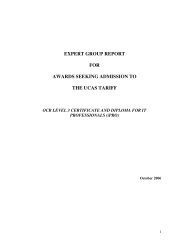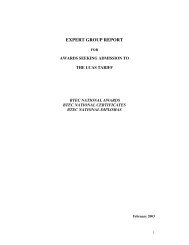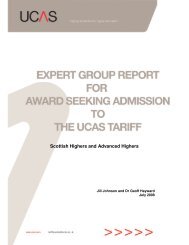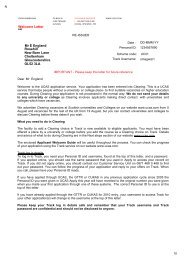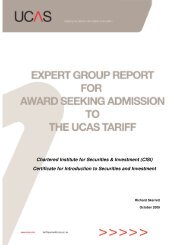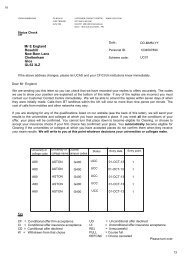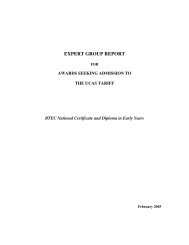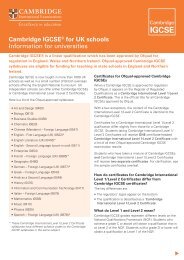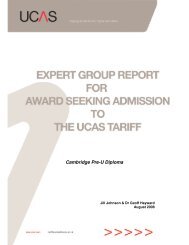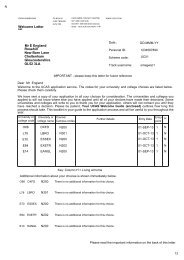International qualifications 2013 (pdf) - CUKAS
International qualifications 2013 (pdf) - CUKAS
International qualifications 2013 (pdf) - CUKAS
You also want an ePaper? Increase the reach of your titles
YUMPU automatically turns print PDFs into web optimized ePapers that Google loves.
Qualifications currently offered<br />
40% or above has been achieved, with the exception of English<br />
language.<br />
Government Technical Institute (GTI) Diploma<br />
Considered to be comparable to BTEC National Diploma/N(S)VQ.<br />
GRADING SYSTEM<br />
School<br />
Marking is on a percentage scale, with a minimum average of<br />
40% as pass-mark which is required for university entrance.<br />
EDUCATION SYSTEM<br />
The education system provides 11 years of schooling. The<br />
admission age is five years. Primary education covers the first<br />
five years of education grade 1 to grade 5: three years of<br />
schooling at lower primary level, two years at upper primary<br />
level. Secondary education lasts six years, divided into two<br />
cycles: four years at the lower secondary level (middle<br />
secondary) and two years at the upper secondary level (higher<br />
secondary). Lower secondary (middle secondary) schooling<br />
covers grade 6 to 9 (previously standard 5 to standard 8). At<br />
the end of grade 9 (standard 8) students sit an examination,<br />
used to route them into the arts or science streams for upper<br />
secondary (higher secondary) grade 10 and 11. At the end of<br />
the upper secondary level (in year 11) students can take the<br />
Basic Education High School Examination (matriculation) to<br />
enter the tertiary level. English, mathematics and Myanmar are<br />
compulsory subjects in the matriculation examination.<br />
ACCESS TO HIGHER EDUCATION<br />
After matriculation at the age of 16+ or 17, depending on their<br />
grades, students would then continue their studies at government<br />
universities or institutions. Admission is based on the<br />
matriculation results (or grade). Some HE institutions require<br />
students to sit an entrance examination.<br />
Nepal<br />
EVALUATION<br />
School Leaving Certificate<br />
Considered to be below GCSE standard.<br />
GRADING SYSTEM<br />
Pass with Distinction 75%+<br />
Pass with 1st Division 60–74%<br />
Pass with 2nd Division 45–59%<br />
Pass with 3rd Division 32–44%<br />
EDUCATION SYSTEM<br />
Education in Nepal is structured as school education and higher<br />
education. School education includes primary level of grades<br />
1–5, and lower secondary and secondary levels of 6–8 and 9–10<br />
respectively. Pre-primary level of education is also available in<br />
certain areas. Six years of age is the prescribed age for<br />
admission into grade one. A national level School Leaving<br />
Certificate (SLC) examination is conducted at the end of grade<br />
10. Grades 11 and 12 are considered as higher secondary level.<br />
Higher Secondary Education Board (HSEB) supervises higher<br />
secondary schools which are mostly under private management.<br />
Higher education consists of bachelor’s, master’s, and PhD levels.<br />
Depending upon the stream and subject, bachelor’s level may be<br />
of three to five years’ duration. The duration of master’s level is<br />
generally two years. Some universities offer programmes like<br />
MPhil and postgraduate Diplomas.<br />
Legally there are two types of school: community and<br />
institutional. Community schools receive regular government<br />
grants whereas institutional schools are funded by their own or<br />
other non-governmental resources. Institutional schools are<br />
organised either as a non-profit trust or as a company. However,<br />
in practical terms, schools are mainly of two types: public<br />
(community) and private (institutional). A third type of school are<br />
schools run by local people keen to have a school in their locality.<br />
ACCESS TO HIGHER EDUCATION<br />
There is no specific range of marks required for admission to<br />
higher education, but rather the requirement of different colleges<br />
that operate under different universities. Generally colleges<br />
require a 1st division result for admission or for eligibility to sit<br />
the entrance test. Until 1985 the only university in Nepal was<br />
Tribhuvan University. However, in the 1980s the government<br />
developed the concept of a multi-university system, with each<br />
new university having their own distinctive nature, content and<br />
function.<br />
EDUCATION ADMINISTRATION<br />
The Ministry of Education and Sports is the apex body<br />
responsible for initiating and managing educational activities in<br />
the country. The Minister of Education, assisted by the<br />
State/Assistant Minister, provides political leadership to the<br />
Ministry. The Ministry, as a part of the government bureaucracy, is<br />
headed by the Secretary of Education and consists of the central<br />
office, various functional offices and offices located at the<br />
regional and district levels. The Central Office or the Ministry is<br />
mainly responsible for policy development, planning and<br />
monitoring and evaluation regarding different aspects of<br />
education.<br />
With the purpose of bringing education administration nearer to<br />
the people, the Ministry has established five Regional Directorates<br />
and 75 District Education Offices in five development regions and<br />
75 districts respectively. These decentralised offices are<br />
responsible for overseeing non-formal and school level<br />
educational activities in their respective areas. Regional<br />
Directorates are mainly responsible for coordinating, monitoring<br />
and evaluating education activities, and the District Education<br />
Offices are the main implementing agencies.<br />
LIST OF UNIVERSITIES IN NEPAL<br />
Prior to the establishment of the first college in the country, Tri-<br />
Chandra College in 1918, higher education in Nepal was<br />
nonexistent. Until 1985, Tribhuvan University had remained the<br />
only university in Nepal. In the early 1980s, His Majesty's<br />
Government developed the concept of a multi-university system<br />
for the country. One important assumption behind the concept<br />
was that each new university should have a distinctive nature,<br />
content and function of its own.<br />
The first new university that was established was Mahendra<br />
Sanskrit University. The inception of this university was soon<br />
followed by Kathmandu University which, unlike Tribhuvan<br />
University or Mahendra Sanskrit University, is an institution of<br />
higher education founded by the private sector.<br />
Currently there are six universities in Nepal:<br />
g<br />
Tribhuvan University<br />
g<br />
Kathmandu University<br />
g<br />
Pokhara University<br />
g<br />
Purbanchal University<br />
g<br />
Mahendra Sanskrit University<br />
g<br />
B.P.Koriala Institute of Health Sciences<br />
INTERNATIONAL QUALIFICATIONS 43



